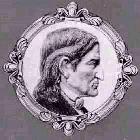
 |
Digital DistortionsImages presented on the World Wide Web are subject to many potential distortions and lack the texture of an original piece of art. |
This website offers:Froebelia
|
It's impossible to reproduce a piece of art. Photographs can do a decent job of representing the original, but only in the hands of a professional. Film has fine spacial resolution - usually better than the eye. So structural distortions and loss of detail are minimal. However, photographs, by their nature, produce flattened images and lack the texture of an original piece of art. And the color rendering in photographs can often misrepresent an original, being distorted by the light used to capture the image, reflected light from surrounding surfaces, and by the characteristics of the film being used. Images presented on the World Wide Web (Web) are also flattened and are subject to many more potential distortions than film. Often digital renderings are produced by scanning photographs, so all of the distortions on film are carried over. To present images on a website, the images need to be broken down into a mosaic of tiny square tiles called "picture elements" or "pixels." These are mosaics are called digital images. While the pixels are small, they are not infinitely small. And only a limited number of them can be presented across the full screen width of your browser (approximately 600 in Netscape). This means that if a painting were divided across its width into 600 equal parts, structural detail finer than that subdivision would be lost. Structural detail within those subdivisions would be averaged. For large paintings, this loss can be significant. Therefore, image detail as seen on the Web is only an approximation of the detail in the original work. Images presented on the Web are subject to color distortions too. To each of the tiny tiles or pixels in a digital image there is an assigned a color. Only two graphic formats are widely supported on the Web, .gif and jpeg. Gif supports a palette of 256 colors selected out of 16 million colors. Jpeg allows using the full 16 million colors to create an image. However, and unfortunately, many browsers and monitors only render an image using their specific and limited palette. For instance, Netscape only supports a 216-color palette for gifs. Those 216 colors are specifically defined. If a .gif image contains a pixel with a color different from one of the 216 Netscape colors, the color in that 216-color palette closest to the image color is used. So the colors presented on the Web are limited and may be different from the actual colors an original. Because the palette for gifs is so limited, we have presented our images in the jpeg format. If your monitor only supports 256 colors, however, there will be distortions. Another problem: We could line up ten computers, all of the same brand and with the same monitors and using the same software browser. If we looked at the same website image, we would find significant differences in the appearance on screen among the ten computers. This is because monitors are never tuned exactly the same in their output of red, green, and blue light. If the ten computers, their monitors, and the software they were running differed in brands and makes, we would find even a greater difference when viewing the same Web image. So hardware and software can also lead to distortions in Web images. Native jpeg files tend to be huge because each pixel can assume so many different color attributes. To make the files small enough so that download times are reasonable for you, we've compressed those images. With compression comes some loss in structural detail. We've tried to choose a compression ratio that allows reasonable downloads without excessive loss in structure. All that said, nothing is perfect. In developing the Froebel Gallery Website, we have tried to represent the artists' work with fidelity. We've done our best to bring you representative images of the artists' works. But we are limited by the constraints mentioned, and we have no control over the hardware or software that is being used to present the images. If you are considering a piece for purchase, please contact the Gallery director for his appraisal of the on-line images. And feel free to request photographs. Better yet, call to arrange a showing. Contact information is provided on the homepage. Copyright © 1997 - 2008 by The Froebel Gallery. All rights reserved. |